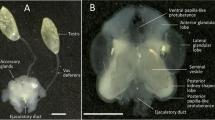Abstract
Although the Ephemeroptera have been studied over a long period of time, there are still few studies on the morphology of male reproductive system. The spermatic ducts are considered conserved among different Ephemeroptera groups. However, previous studies distinguished different organizational patterns of the spermatic duct intrinsic musculature. This study describes the morphology of the spermatic ducts, especially their musculature, in six species of Ephemeroptera, representing five families. We have observed variations in the organizational pattern of the spermatic ducts, even between species from the same family. Moreover, all species studied had intrinsic musculature in the spermatic ducts although with different organizational patterns. Thus, we believe that this musculature is important to move the spermatozoa along the ducts of all Ephemeroptera and not only of those with aflagellated spermatozoa (Leptophlebiidae). The variations in musculature organization must be related to differences in reproductive physiology (i.e., copula duration) and not only with spermatozoa characteristics.



Similar content being viewed by others
References
Baccetti B, Dallai R, Giusti F (1969) The spermatozoa of Arthropoda. VI Ephemeroptera. J Ultrastruc Res 29:343–349
Brinck P (1957) Reproductive system and mating in Ephemeroptera. Opusc Ent 22:1–37
Brito P, Salles FF, Dolder H (2011) Characteristics of the male reproductive system and spermatozoa of Leptophlebiidae (Ephemeroptera). Neotrop Entomol 40:103–107
Dallai R, Afzelius BA (1990) Microtubular diversity in insect spermatozoa: results obtained with new fixative. J Struc Biol 103:164–179
Gaino E, Mazzini M (1991) Spermatozoon of mayflies (Ephemeroptera): an ultrastructural approach. In: Alba-Tercedor, Sanchez-Ortega (eds) Overview and strategies of Ephemeroptera and Plecoptera. The Sandhill Crane Press, USA, pp 27–38
Grimm VR (1985) Vergleichend-anatomische Untersuchong der abdominalen Muskulatur und der Gonoducte manlicher Ephemeroptera-Imagines (Insecta). Stuttgarter Beitr Naturk 384:59
Jamieson BGM, Dallai R, Afzelius BA (1999) Insects: their spermatozoa and phylogeny. Science Publisher, USA, p 555
Pescador ML, Peters WL (1980) A revision of the genus Homoeoneuria (Ephemeroptera: Oligoneuriidae). T Am Entomol Soc 106:357–393
Quadri MAH (1940) On the development of the genitalia and their ducts of orthopteroid insects. T Roy Entomol Soc Lond 90:121–175
Soldán T (1979a) The structure and development of the male internal reproductive organs in six European species of Ephemeroptera. Acta Entomol Boh 76:22–33
Soldán T (1979b) A comparative study of spermatozoa of some central European Ephemeroptera. Acta Entomol Boh 76:223–230
Swammerdam J (1681) Ephemiri vita: or the natural history and anatomy of the Ephemeron. A fly that lives but five hours. Henry Faithorne and John Kersey, London
Werner M, Simmons LW (2008) Insect sperm motility. Biol Rev 83:191–208
Acknowledgments
The authors would like to acknowledge Dr. Neusa Hamada, Paulo V. Cruz, and Rafael Boldrini for their support provided for specimen collection. The specimen collection expeditions were partially supported by PRONEX/CNPq/FAPEAM. This study was financed by the Brazilian agencies Fapesp and Capes/PROEX. FFS is a fellowship holder of CNPq (Brazilian Research Council).
Author information
Authors and Affiliations
Corresponding author
Additional information
Edited by Roberto A Zucchi – ESALQ/USP
Rights and permissions
About this article
Cite this article
Brito, P., Salles, F.F. & Dolder, H. Morphology of Male Reproductive Systems in Ephemeroptera: Intrinsic Musculature. Neotrop Entomol 41, 306–310 (2012). https://doi.org/10.1007/s13744-012-0039-7
Received:
Accepted:
Published:
Issue Date:
DOI: https://doi.org/10.1007/s13744-012-0039-7




